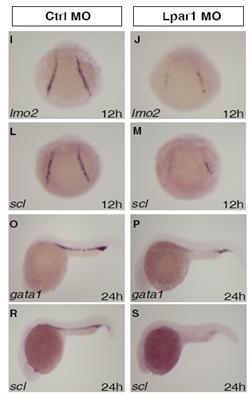
Nutrient-derived Lysophosphatidic Acid Guides Early Hematopoiesis
May 27, 2014 Email"> PrintText Size

Primitive hematopoiesis occurs in the yolk sac blood islands, where hemangioblasts give rise to the primitive erythrocytes through asymmetric cell division. Interestingly, a large amount of nutrients such as phosphatidylcholines (PC) also exist in this area to provide energy for the developing embryo. PC is hydrolyzed by the secreted phospholipase A2 into lysophosphatidylcholine (LPC), and LPC can be further hydrolyzed by autotoxin (ATX) into lysophosphatidic acid (LPA). However, whether these lipid molecules can act as developmental cues for hematopoietic development is still unknown.
Recently, a team of researchers led by Prof. PEI Gang at the Institute of Biochemistry and Cell Biology (SIBCB), Shanghai Institutes for Biological Sciences, discovered that LPA is a critical regulator of hemangioblast formation and primitive hematopoiesis.
They found that LPA receptor 1 (Lpar1), a G protein-coupled receptor (GPCR), is notably up-regulated during in vitro hematopoietic differentiation of mouse embryonic stem cells (mESCs) by combining with bioinformatic analyses. Pharmacological or genetic inhibition of Lpar1 or ATX significantly impaired mESCs hematopoietic differentiation, which could be attributed to decreased hemangioblast formation.
Mechanistic studies revealed that PI3K/Akt-Smad pathway mediates the downstream effects of ATX-LPA signaling. Furthermore, in vivo experiments showed that ATX-LPA signaling is required for hemangioblast formation and primitive hematopoiesis during zebrafish embryogenesis.
Their study not only showed that nutritional substances can generate an essential developmental cue for primitive hematopoiesis, but also identified a novel GPCR signaling pathway regulating hemangioblast formation.
This work entitled “Lysophosphatidic acid acts as a nutrient-derived developmental cue to regulate early hematopoiesis” was published online in The EMBO Journal on May 14th, 2014.
This study was supported by grants from the Chinese Academy of Sciences, the Ministry of Science and Technology, the Ministry of Health, Shanghai Municipal Commission for Science and the National Natural Science Foundation of China.

LPA signaling is required for hemangioblast formation and primitive hematopoiesis in zebrafish. (I–S) Whole mount in situ hybridization analyses. Zebrafish embryos injected with Ctrl MO, or Lpar1 MO were hybridized with riboprobes to hemangioblast markers lmo2 (I and J) and scl (L and M) at 12 hpf, or with riboprobes to primitive hematopoietic markers gata1 (O and P) and scl (R and S) at 24 hpf (Image by Prof. PEI Gang`s group).
Primitive hematopoiesis occurs in the yolk sac blood islands, where hemangioblasts give rise to the primitive erythrocytes through asymmetric cell division. Interestingly, a large amount of nutrients such as phosphatidylcholines (PC) also exist in this area to provide energy for the developing embryo. PC is hydrolyzed by the secreted phospholipase A2 into lysophosphatidylcholine (LPC), and LPC can be further hydrolyzed by autotoxin (ATX) into lysophosphatidic acid (LPA). However, whether these lipid molecules can act as developmental cues for hematopoietic development is still unknown.
Recently, a team of researchers led by Prof. PEI Gang at the Institute of Biochemistry and Cell Biology (SIBCB), Shanghai Institutes for Biological Sciences, discovered that LPA is a critical regulator of hemangioblast formation and primitive hematopoiesis.
They found that LPA receptor 1 (Lpar1), a G protein-coupled receptor (GPCR), is notably up-regulated during in vitro hematopoietic differentiation of mouse embryonic stem cells (mESCs) by combining with bioinformatic analyses. Pharmacological or genetic inhibition of Lpar1 or ATX significantly impaired mESCs hematopoietic differentiation, which could be attributed to decreased hemangioblast formation.
Mechanistic studies revealed that PI3K/Akt-Smad pathway mediates the downstream effects of ATX-LPA signaling. Furthermore, in vivo experiments showed that ATX-LPA signaling is required for hemangioblast formation and primitive hematopoiesis during zebrafish embryogenesis.
Their study not only showed that nutritional substances can generate an essential developmental cue for primitive hematopoiesis, but also identified a novel GPCR signaling pathway regulating hemangioblast formation.
This work entitled “Lysophosphatidic acid acts as a nutrient-derived developmental cue to regulate early hematopoiesis” was published online in The EMBO Journal on May 14th, 2014.
This study was supported by grants from the Chinese Academy of Sciences, the Ministry of Science and Technology, the Ministry of Health, Shanghai Municipal Commission for Science and the National Natural Science Foundation of China.

LPA signaling is required for hemangioblast formation and primitive hematopoiesis in zebrafish. (I–S) Whole mount in situ hybridization analyses. Zebrafish embryos injected with Ctrl MO, or Lpar1 MO were hybridized with riboprobes to hemangioblast markers lmo2 (I and J) and scl (L and M) at 12 hpf, or with riboprobes to primitive hematopoietic markers gata1 (O and P) and scl (R and S) at 24 hpf (Image by Prof. PEI Gang`s group).
CAS Institutes
There are 124 Institutions directly under the CAS by the end of 2012, with 104 research institutes, five universities & supporting organizations, 12 management organizations that consist of the headquarters and branches, and three other units. Moreover, there are 25 legal entities affiliated and 22 CAS invested holding enterprisesThere are 124 I...>> more
Contact Us

Chinese Academy of Sciences
Add: 52 Sanlihe Rd., Xicheng District, Beijing, China
Postcode: 100864
Tel: 86-10-68597592 (day) 86-10-68597289 (night)
Fax: 86-10-68511095 (day) 86-10-68512458 (night)
E-mail: cas_en@cas.cn

